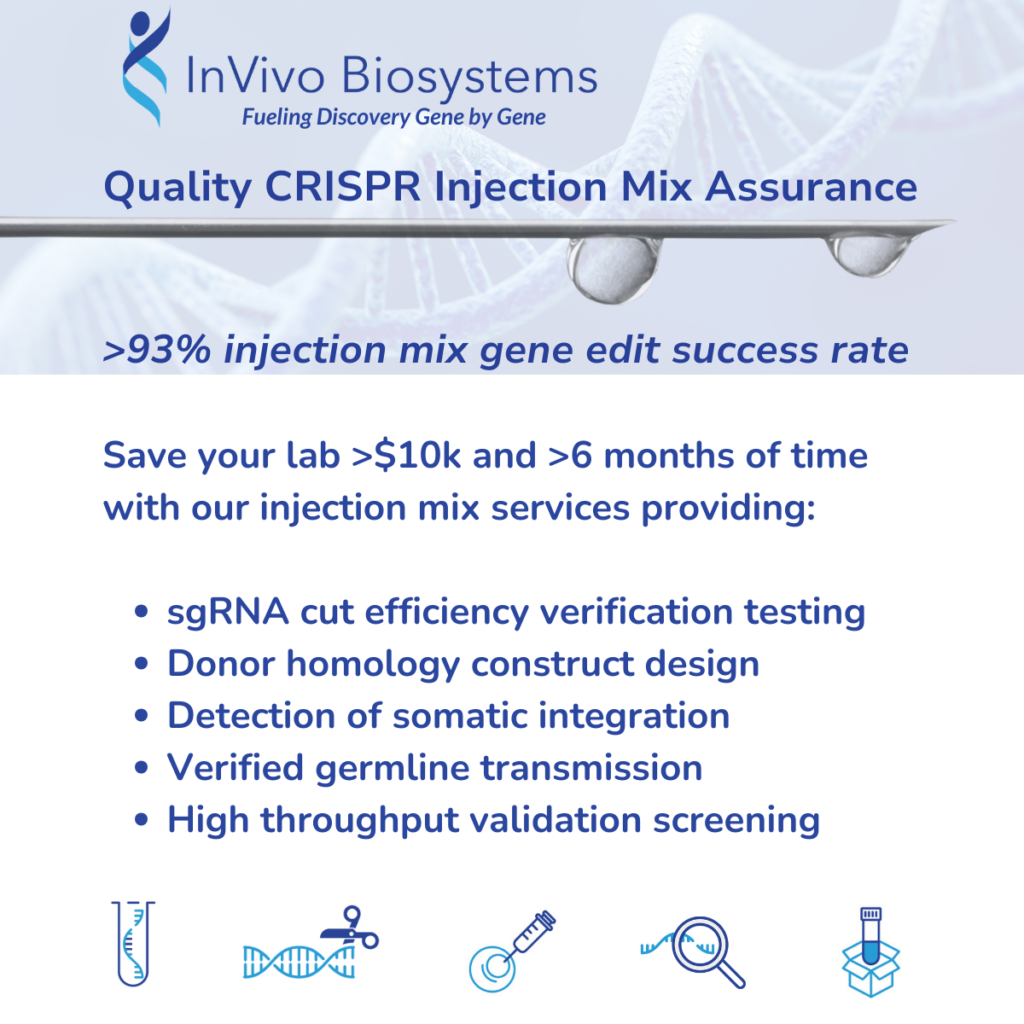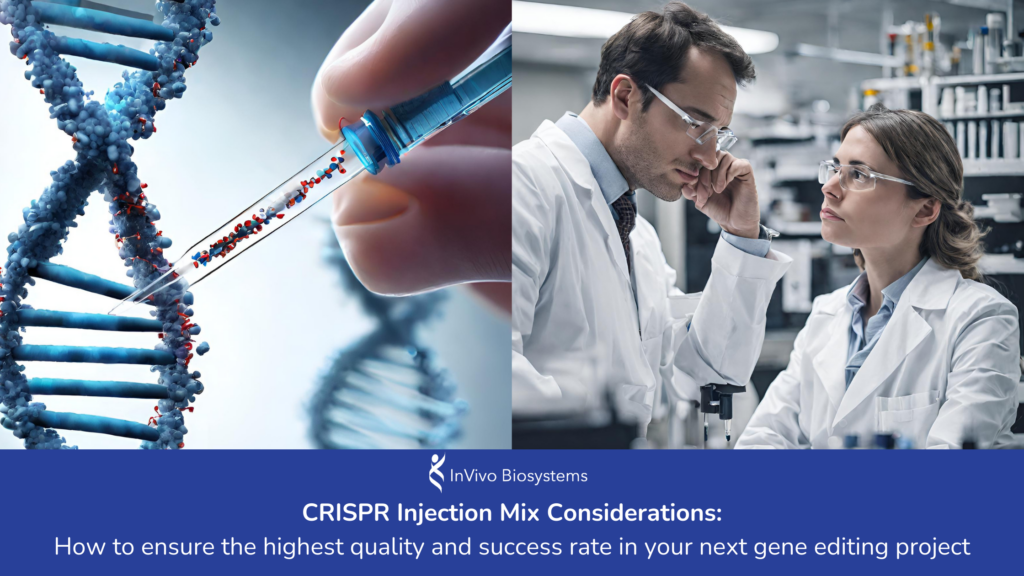As CRISPR injection mixes have become more readily available to make genome editing easier, it can be difficult to determine what the value is of utilizing a Contract Research Organization (CRO) rather than buying a readily available CRISPR injection mix or designing one yourself. Whether you are just starting out or are a CRISPR-veteran, any successful edit can be a daunting task.
Each successful gene edit starts with a properly formulated injection mix. Here, we share with you some trade knowledge from our experience of creating thousands of precisely genome-edited zebrafish and C. elegans. Whatever stage you are at in your genome editing project, InVivo Biosystems can help move your project forward.
Key Points
- The success of a CRISPR gene edit depends on the quality of the injection mix and there are many factors to consider. You can make the effort to optimize the formulation yourself or choose to have a provider like InVivo Biosystems prepare a validated mix for you.
- To ensure your injection converts to a successful edit, you will want to have a screening strategy and the resources to carry it out before injecting.
- In addition, you will want to make sure that you have a large enough population of injected embryos and the animal facility space to maintain and screen your fish until you have confirmed your edit.
Gene Edit Type
Do I want to make a gene Knock-Out? a point mutation? a Knock-In?
The type of edit will have the greatest impact on what goes into your mix. A Knock-Out produced by a simple lesion in the gene might need guide RNAs only, whereas a precise point mutation will require the addition of a donor homology template. The donor homology template can take many forms, and larger Knock-Ins, such as for a fusion tag, require more optimization. You also want to consider how many edits you intend to make, as rapid knockouts, or Crispants might be better suited to screening multiple target genes or mutations.
Steps to a Successful Knock-In
Injection Mix Reagents
Is Cas9 or Cas12a a better nuclease for generating my edit? Although Cas9 has been the backbone of CRISPR technologies since their inception, Cas12a has demonstrated advantages for some applications. The wider availability of tools and reagents for Cas12a makes it worthwhile to ask whether Cas12a would unlock more reliable sgRNA recognition sites or more efficient insertion of your donor homogy template for your application.
Which guide RNAs are likely to be strong cutters at my target locus?
Online sgRNA prediction tools are indispensible for finding effective sgRNA target sites with low predicted off-target effects; however empirically testing candidate sgRNA sites and measuring cleavage efficiency will go a long way to ensure the success of your edit. For this reason, we offer and recommend the option of pre-validating sgRNAs for Custom Injection Mixes that we produce.
How should I design my donor homology construct?
Informed selection of donor homology construct design features can improve the success of introducing your desired edit into the target locus. Single stranded DNA templates have been a prominent standard, but double-stranded DNA or plasmid DNA might favor more consistent repair processes.
Which injection mix reagents and quantities are best?
Combining the components of your mix in optimal concentrations and ratios will help favor your desired edit. We have carefully optimized the formulation of Custom Injection Mixes that we produce, but there also exist online calculators that will provide a viable starting point for setting up your own mixture.
Do I have the expertise to design an injection mix by myself?
Yes, you can do this. There is an abundance of tools and resources to make CRISPR based gene editing accessible to a broad range of experience levels and budgets. However, the right question is whether your time and resources could be put to better use by working with a trusted provider like InVivo Biosytems.

Validation Screens - Planning is Key
How do I determine whether my injection reagents are effective?
You don’t want to wait 3-4 months for injected fish to reach adulthood just to find out whether your injection reagents worked. That’s why having a strategy for validating your edit after injection is just as important as what you put into your injection mix. Before you inject, make sure you have addressed the following questions, and have the tank and nursery space to carry out your plan.
How do I detect which fish acquired the edit?
You want to quickly know whether your injections and reagents were effective and focus your resources on maintaining only a population most likely to have a successful edit. Including a dye in your injection mix will help to rapidly remove embryos from the population that were not successfully injected. To detect somatic editing or integration a co-marker such as a GFP construct is ideal, but not always compatible. A pooled PCR screen can indicate whether a sufficient fraction of the population acquired the edit to proceed. Keep in mind that you will need to maintain a large enough population to eventually recover those individuals with germline edits.
How do I detect germline transmission of my edit?
Recovering animals with germline edits is essential to creating a stable line, but this step requires growing animals to adulthood such that a molecular assay can be used to screen their progeny. Becuase of the level of time and resources committed to this step, the design of this molecular screening assay should go hand-in-hand with the design of your mix even though it will be months down the road.
Do I have the resources to design and run validation screens?
Zebrafish offer an excellent alternative to rodent models in terms of the 3Rs (Reducing, Refining, Replacing), even so, it is important to consider tank and nursery space in your workflow. Making sure that you have the capacity to carry a sufficient population for screening and the resources to perform the screening efficiently will help avoid losses late in the process.
At inVivo Biosystems, optimized screening strategies and ethical animal maintenance are integrated within our workflows to ensure that successful injections are consistently converted to stable genome-edited lines.
We're here to help at any stage
These are all questions you should address before embarking on your first zebrafish genome editing project. It is particularly important to make sure that you have a screening strategy developed at the outset. Some labs will have the resources on hand to efficiently assemble and optimize their own injection mixes, whereas others will benefit from outsourcing their genome editing. Even with the right tools and expertise on hand, many will find a genome editing provider like InVivo Biosystems advantageous in the fast paced world of research and discovery. Whatever you need just an injection-ready mix formulated or need a completed zebrafish line, we can help at any stage in your genome editing process.




